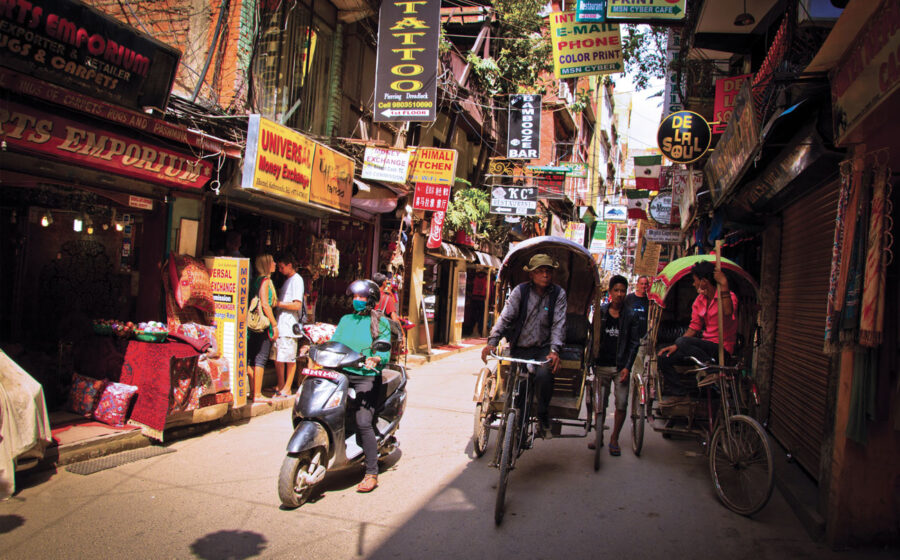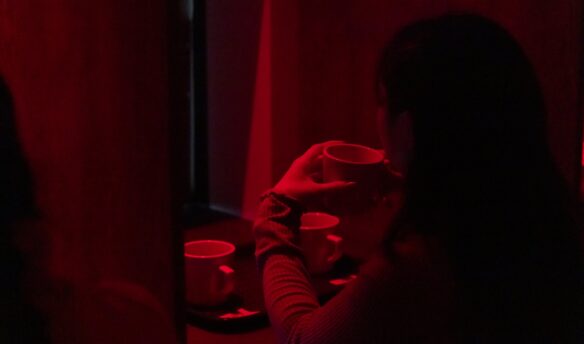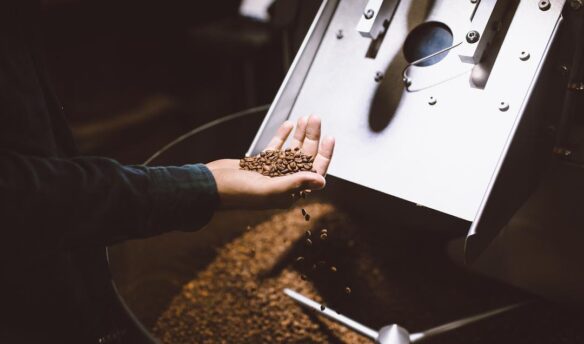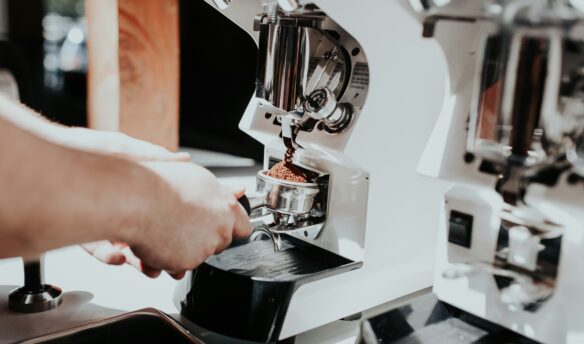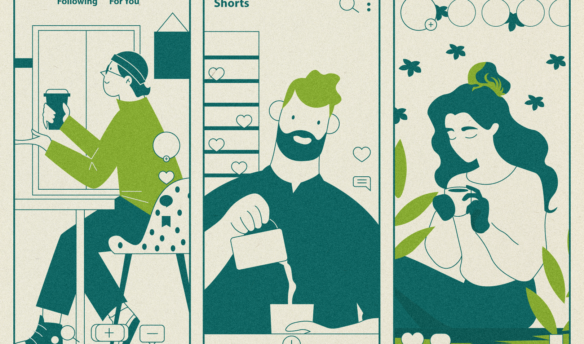[B]eyond the frozen slopes of Mount Everest and the trails that take avid adventurers to its base, the nation of Nepal remains both remote and wondrous. Kathmandu, the capital and home to 2.5 million people, is the center of trade, tourism, and, though few know it, also coffee in this landlocked nation. Despite the damage from the 2015 earthquake that is still visible, the city remains vibrant and alive. It’s a city that overwhelms the senses. Tourists walk through the smog-filled city past countless shrines, vibrant colors, aromatic spices, and shouting peddlers hawking everything from live chickens to lip balm. It is here, buried in the morass of development and clutter, that specialty coffee is emerging. One just needs to know where to find it.
A coffee tour of Kathmandu starts in the district of Thamel. The layover for adventure seekers heading into one of many trails and mountaintops, Thamel has hosted famous mountaineers and explorers for decades. Regardless of purpose, a foreign visitor is referred to as a tourist and these tourists and their demands for the comfort of home after a long journey have resulted in a burgeoning food and coffee scene in the district. As such, it makes the perfect home for one of the rapidly expanding local café chains, Himalayan Java.
Owner Madhav Devkota greets me with a smile and removes his sunglasses. Gesturing for me to sit down, he points at his idle roaster in the corner of his café space. “We’d be roasting, but we have no damn gas,” he says. India’s blockade is what he refers to, the result of a dispute of regional influence and authority that has shuttered the major trade routes with India, just about the only arteries to the outside world. A well-dressed waiter arrives and places an espresso, small piece of chocolate cake, and water on a beautiful ceramic tray. Nearly every café in town has table service, a bit of Old World charm still battling the rising tide of “order here and pickup there” counter service in the rest of the world.
The café itself is exquisite. On the second floor of the building, it looks over the street without any windows or shutters blocking the views. Woodwork and earth tones invite and calm the weary traveler, taking away the stress that comes with navigating the streets below. My discussion with Devkota swings to the espresso and specifically crema, a topic, among others, he discusses with customers regularly. Why crema? “Not many people understand coffee, let alone espresso. We try to educate them with barista classes, and it is changing—slowly though,” Devkota says. “I’m serious enough that we’ll be opening in the States soon. Believe me.” He smiles. “Your coffee culture is established and many Nepalese in the States crave a piece of home. We want to bring a bit of Nepal to them and to you.”
Departing Himalayan Java, I meet with another coffee guru, Nima Tenzing Sherpa. A young man with a powerful smile and cheerful demeanor, he is the owner of Lekali Coffee Estate and arguably the only specialty coffee grower in Nepal. Known in Kathmandu for dedication to quality, his coffees are gaining traction in established specialty coffee markets elsewhere. Climbing into his car, he says, “The smog won’t be bad today.” He laughs, “The block of course!” Gas, he explains, is on the forefront of every coffee professional’s mind in the city. He certainly does not waste any time speeding out into the street amid honks and swerving motorbikes.
I learn quickly that the streets of Kathmandu have one rule. Don’t stop. Weaving in and out of buses, cows, motorbikes, and scores of pedestrians, our car drives past quake-damaged buildings and pristine villas on the way to his roasting facility. “The damage is everywhere,” says Sherpa of the earthquake that hit Nepal in April of last year and killed nearly 9,000 people. “Much of the supplies and money went straight to the Everest region. The city will take time to recover. The villages are either wiped out or barely starting to rebuild.”
As we near his facility, he changes the conversation from recovery to coffee. He explains that most people in Nepal drink instant coffees or coffee from one of the larger European commercial brands. The change in demand to specialty coffee has much to do with the experience of Nepalese workers abroad who return home. “They try something nice in the US, England, Qatar, and want that here,” he says. Some of the credit belongs to foreign workers and tourists, but they alone cannot drive the demand.
Upon our arrival at his facility in Kathmandu, the first thing that jumps out at the visitor is the Ethiopian raised beds, shaded from the sun and tended by a small staff. One worker is even hand-sorting out quakers from a coffee Sherpa is not, he admits sorrowfully, happy with having sourced locally. “It’s hard to roast the bad coffees from Nepal, both technically and because of pride. The growers and the government coffee board just don’t care or just do not know what impact quality has on the roast.” Coffee samples line the walls, a heavily used Le Nez du Café kit sits next to oranges and apples, and every manner of brewing device one would find in Seattle or Melbourne or Oslo graces a back table; with the exception of the Mr. Coffee of course. “Sometimes the workers just want bad coffee,” Sherpa says. He laughs with a shrug as he loads up his roaster, a five-kilogram Toper. “This is for one of our café partners, but you should visit two or three others here before you leave, and I will bring you. They are known all throughout Kathmandu.”
After a few roasts, we’re back on the roads. Trying to cross a road to then turn down another street, driver refuse to give way, even when Sherpa swings into the oncoming traffic. We jolt forward in front of a wall of scooters and onto a questionably maintained byway, and the road suddenly loses its sense of chaos. In a back alley where a pack of dogs scurries out of the way, an Australian climber rappels down the side of a building and bounces off the balcony where Kar.ma Coffee resides. It shares a space with apartments and a mountaineering company. Our rappelling Australian friend decided to beat us to the counter and, literally, swung into the café for a break.
Located in Patan, its own city but wholly connected to Kathmandu, and housed on the second story of a commercial building, this shop would find a home anywhere in a hip American city. This café uses local coffees and also has connections with roasters in Taiwan and Japan. Hand-crafted woodwork and art adorn the walls. Kettles sit atop electric and gas stoves. Baristas facing a central sitting area brew coffee and serve beverages in ceramic mugs to customers typing away on laptops on the balcony. The coffee, owner Birgit Lienhart-Gyawali explains, comes from Taiwan today.
An espresso blend and a single-origin, both familiarly light, are brewed. Lienhart-Gyawali asks Sherpa, “Do you have gas? The lack of gas has me using electric kettles for brewing.” Sherpa smiled. “I’m managing.” Most of the city runs on kerosene or propane canisters, as the electrical grid is an afterthought at best. Taking a long journey up a staircase is preferable to the elevator in any building with the threat of a power outage always in the back of one’s mind. Brewing with gas burners is reliable and keeps the coffee flowing throughout the many lengthy power outages.
Lienhart-Gyawali sits down with us and explains her unique approach to brewing coffee in Kathmandu. “People are demanding better coffee here and the culture can support places like this. It’s part of why I started Kar.ma,” Lienhart-Gyawali says. Focusing on pour-overs via V60 and Chemex, she hires local artists to recycle and reuse the filters turning them into works of art. They carefully clean, dry, and decorate the filters for sale and for display. “One of the big issues we have is logistics of course.” She gestures to her coffees on display on the wall. “We buy it and supplies from local sources when the quality is there, but getting anything from out of the country is so expensive unless you bring it in yourself.” The heavy import tax in Nepal, upward of 250 percent, makes it difficult for small, specialty-oriented owners to import equipment and other standards in the cafés of Europe, Asia, and North America. It is what, in part, gives rise to distributors who hoard goods and parts to sell at inflated prices. Still, like everyone in Nepal, Kar.ma manages.
As the day in Kathmandu gives way to evening, a phone call comes in. “They have gas now!” Sherpa declares with a smile. “Come, let’s visit Café Soma!” We drive toward the Russian Embassy and pull into a quiet courtyard. The English-Nepali owner takes great care to prepare and serve exquisite meals to affluent locals, diplomats, and tourists wandering out of familiar territory. Café Soma is the pride of breakfast lovers across Kathmandu and visitors from the embassies that crowd this city block.
Café Soma primarily uses Lekali Coffee Estate but buys an assortment of other specialty roasts when they are available. Their espresso machine is meticulously maintained. Barista tools, cleaning equipment, and supplies are kept at the ready and used often. Surrounding the counter space are burlap coffee bags and some local art. The courtyard itself, taking up over ninety percent of the café space, is immaculate. Flowers, a manicured lawn, and ample covered table space give it a British countryside feel. Guests are treated to a variety of familiar coffee beverages and foods served with a side of bottled water. The water from the tap is not safe to drink, and every café with an espresso machine uses delivered five-gallon jugs. Seltzer is unheard of. The barista produces a macchiato and pours a lovely heart that is crisp and well defined in the center of the small cup.
The sun sets and a busy evening begins to give way to night. The honking of traffic subsides, fires dot the hillsides beyond the valley, and the café begins to prepare for the dinner rush. It is a welcome moment of serenity and a fine end to a coffee crawl around a bustling city at the top of the world.
—Andrew Russo is coffee and strategy specialist at Catalyst Coffee Consulting.


